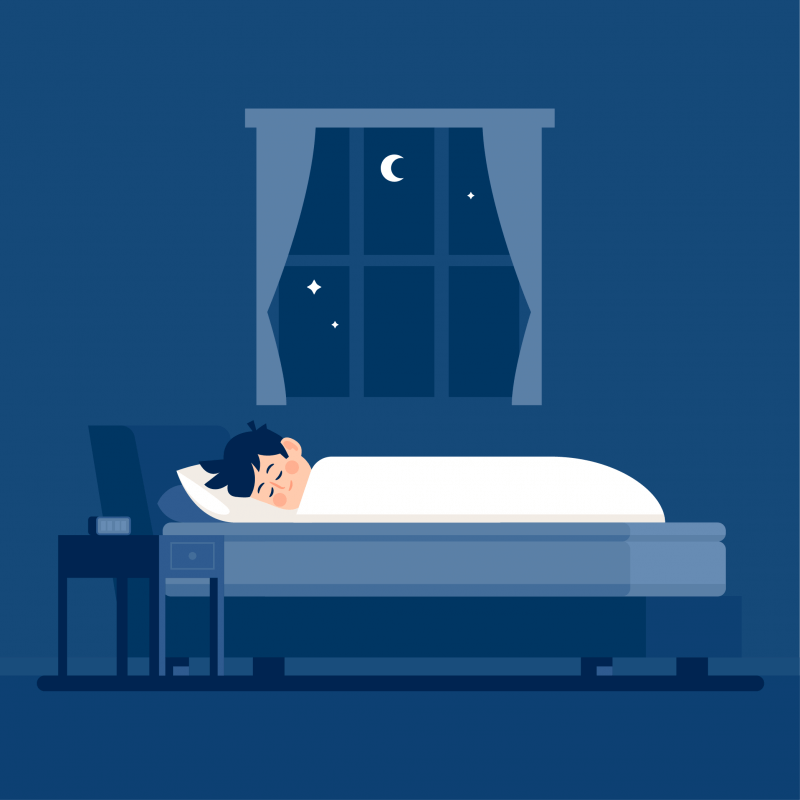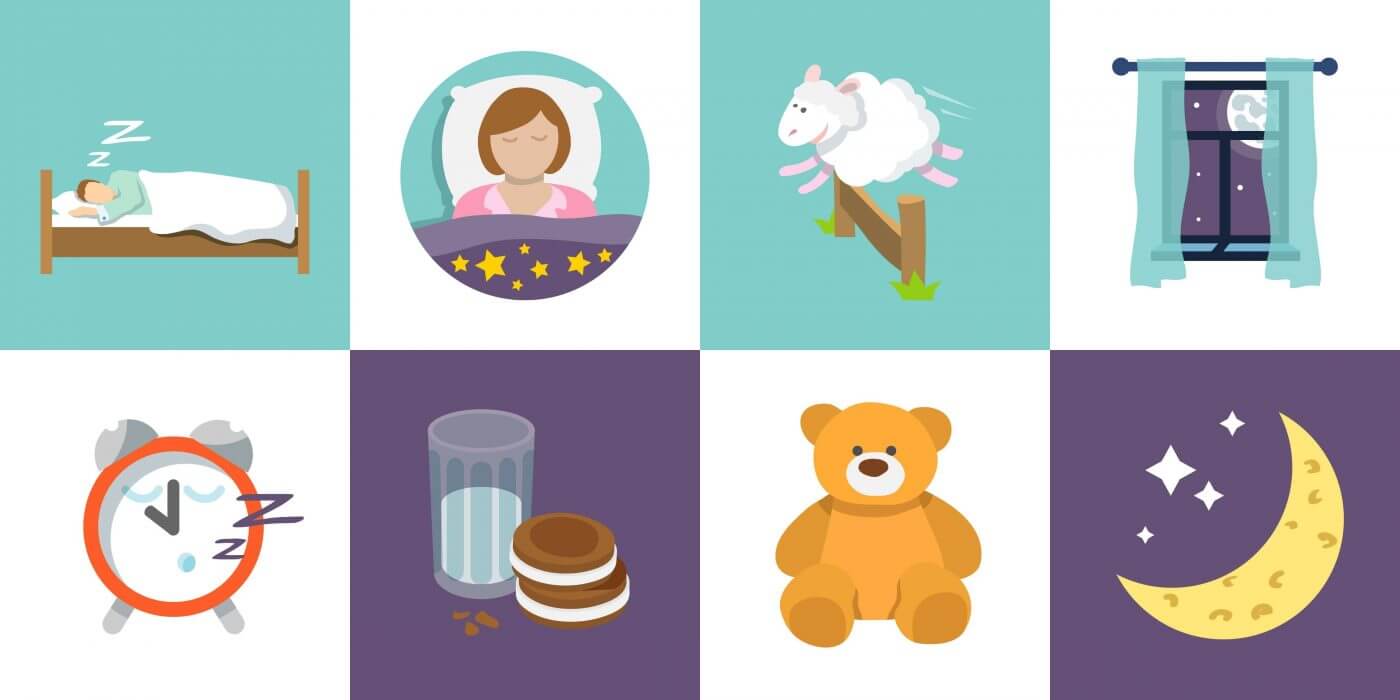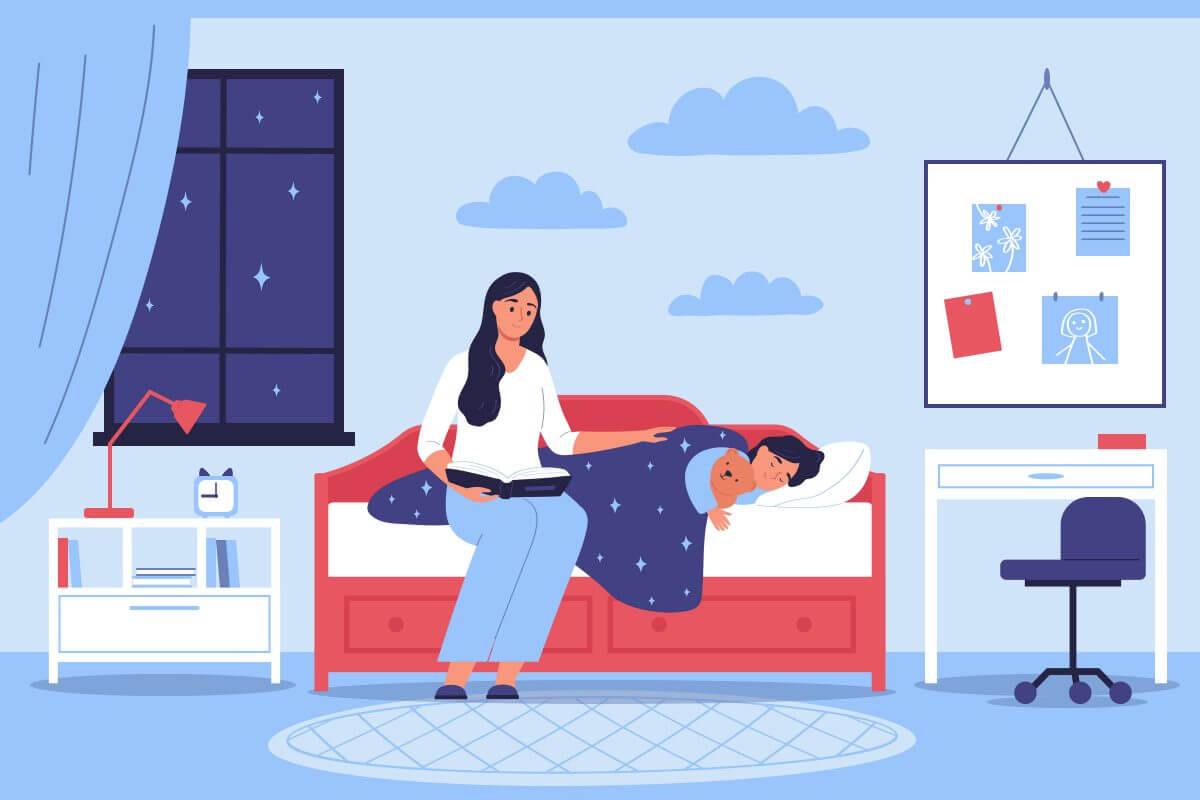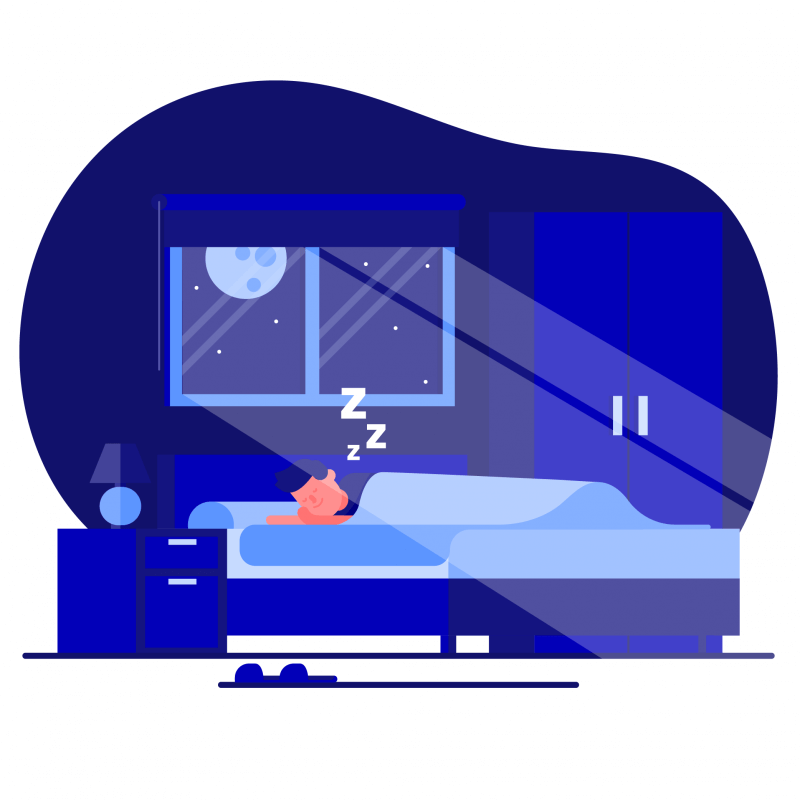Tips for Good Sleep Hygiene
You may be familiar with the term “sleep hygiene,” with some of you already incorporating it into your daily routines. Sleep hygiene refers to the creation of an environment and a routine conducive to sleep. Sleep is vital, not just for us, but more so for the little ones, as it plays a crucial role in their overall well-being and development. If you wish to know more about the importance of sleep and what sleep looks like in children, click here to visit our page for more useful information!

So, here are a few tips to improve your children’s sleep hygiene and, hopefully, ensure a more restful sleep for both you and your children:

First, the sleeping environment is important! The journey to improving sleep often begins by creating an environment conducive to rest and relaxation. As human beings, we depend on certain environmental factors to facilitate our transition into sleep.
- Temperature: A slightly cool bedroom temperature can significantly enhance a child’s sleep. Studies suggest that maintaining the room around 16-22°Celsius promotes sleep by stimulating the secretion of melatonin, a hormone essential to a restful slumber.
- Ventilation: Ensuring the child’s bedroom is suitably ventilated for fresh air circulation is crucial. It contributes not only to good indoor air quality but also has a profound effect on overall sleep quality.
- Lighting: The room should be well-lit during the day and dim at night. A darker room during nighttime induces the body to produce melatonin, the sleep hormone, which promotes restful sleep. In the morning, introduce gentle, natural sunlight to stimulate your child’s wakefulness.
- The sense of security and being safety: A child’s bedroom should exude a sense of safety and security. Be careful to control noise levels and lighting. Some children might be uneasy in total darkness, and, in such cases, a night lamp can provide comfort, ensuring they feel safe while sleeping.

A solid sleep routine is fundamental to achieving sound sleep. An effective routine transcends mere bedtimes; it includes a consistent, comprehensive steps that strategically prepares a child for rest and sleep.
- Consistency is key: Establishing fixed bedtimes and wake-up times for children, even on weekends, significantly enhances their overall sleep. This consistency helps reinforce their internal body clock, thereby fostering healthy sleep patterns.
- Recognise sleepiness signs: Always guide your children towards bed when they start showing signs of sleepiness, yet while they’re still alert. This practice not only encourages independent bedtimes but also fosters their ability to self-soothe and transition smoothly from nighttime activities to settling to sleep.
There are two primary methods to foster independent sleep habits in children:

This is suitable for parents who help children transition to sleep by physically comforting them, such as patting or stroking, until they’re settled. First, comfort your child in bed. If they cry, check on them at set intervals and comfort them again. Start with short intervals, such as one minute, and gradually extend them to three minutes, and so on. Repeat this process until the child can fall asleep independently.
This is ideal for parents who plan to be present in the child’s sleeping environment for an extended period, with minimal disruption. Initially, stay next to your child until they fall asleep. Once the child gets used to a structured sleep schedule, gradually remove yourself from their room. They often find this method more comfortable than interval comforting. Start with patting them to sleep, then just sit next to them, and finally remove your presence in the room once the child develops the ability to settle independently.
- Warm Milk: Research suggests that having warm milk before bed can assist with sleep. Components in milk, like tryptophan, can help with the production of serotonin and melatonin, hormones that can positively influence mood, cognitive function, and sleep, respectively.
- Avoid Caffeine: Caffeine is a stimulant found in fizzy drinks, coffee, tea, and energy drinks. It can interfere with sleep initiation. Therefore, try to avoid these beverages close to bedtime.
- Limit Large Meals: Eating large meals before bedtime could disrupt your child’s sleep. The digestive process after a heavy or sugary meal can impede sleep, according to research.
- Warm Water Bath/Shower: A warm bath or shower approximately 30 minutes to 1 hour before bedtime can aid in sleep onset. If it fits into the family schedule, this could be incorporated into the nighttime routine.
- Wind-Down Session: A wind-down session before bed can be beneficial in transitioning your children from an active, alert mindset to a relaxed one. This approach can gradually soothe a busy mind and prepare the body for restful sleep.
Implementing a well-structured bedtime routine is key. Here’s an example of how you could plan it:
10 hours before sleep: Avoid caffeine consumption. This includes beverages like coffee and tea.
3 hours before sleep: Reduce food and drink intake. This allows for easier digestion.
2 hours before sleep: Avoid engaging in heavy work activities, intense study sessions, or vigorous physical games. This facilitates both physical and mental preparation for rest.
1 hour before sleep: Limit the use of electronic devices such as tablets, phones, gaming consoles, PCs, and TVs. Instead, engage in calming activities like listening to soothing music or taking a warm bath.
Just prior to sleep: Initiate the bedtime routine. Have your child put on comfortable pyjamas, read them a bedtime story, or perhaps sing a comforting lullaby. Remember, maintaining a consistent routine is as crucial as the steps within it.
- To reinforce the association between sleep and their bed for your child, it is advisable for children to retire to bed only when they’re feeling sleepy.
- If children are unable to fall asleep once in bed, consider a ’15-minute interval break.’ Encourage your child to go to another room and return only when they start feeling sleepy. This tactic strengthens the connection between sleep and the bedroom environment.

Here are some “don’ts” in sleep hygiene to remember:
- Electronic devices should be prohibited in the children’s bedroom, especially not used in bed. Set a tech curfew about 1.5 hours before bedtime.
- Avoid letting your child fall asleep while sucking or mouthing a milk bottle.
- Avoid playing upbeat or loud music before bedtime in the house.
Additional overarching tips:
- Encourage daytime activity. Regular physical exercise can promote better sleep for your children. Remember, however, to conclude these activities at least 2 hours before bedtime.
- Manage daytime naps wisely. A quick nap around 12-1 pm can be refreshing but try not to let them nap after 4 pm. Nap durations should ideally be around 5-30 minutes. This can help build up sleep pressure during the day, paving the way for better nighttime sleep.
We hope these tips are helpful! Stay tuned for more useful resources coming into your way!
Armstrong, K. L., Quinn, R. A., & Dadds, M. R. (1994). The sleep patterns of normal children. Medical Journal of Australia, 161(3), 202-205.
Carskadon, M.A., & Dement, W.C. (2011). Monitoring and staging human sleep. In M.H. Kryger, T.
Department of Psychology Sleep Research Clinic and Laboratory. Sleep Hygiene. Department of Psychology. DOI: https://www.psychology.hku.hk/sleep/asd/tips-5.html.
Family Health Service, Department of Health . (2023). Parenting Series 5 – The lullaby I – Developing Regular Sleep Patterns. DOI: https://www.fhs.gov.hk/english/health_info/child/13043.html.
Roth, & W.C. Dement (Eds.), Principles and practice of sleep medicine, 5th edition, (pp 16-26). St. Louis: Elsevier Saunders.
Galland, B. C., & Mitchell, E. A. (2011). Helping children sleep (vol 95, pg 850, 2010). ARCHIVES OF DISEASE IN CHILDHOOD, 96(6).
Hannan, K., & Hiscock, H. (2015). Sleep problems in children. Australian family physician, 44(12), 880-884.
Healthdirect. (2023). Sleep tips for children. DOI: https://www.healthdirect.gov.au/sleep-tips-for-children.
Matricciani, L. A., Olds, T. S., Blunden, S., Rigney, G., & Williams, M. T. (2012). Never enough sleep: a brief history of sleep recommendations for children. Pediatrics, 129(3), 548-556.
Matricciani, L., Paquet, C., Galland, B., Short, M., & Olds, T. (2019). Children’s sleep and health: a meta-review. Sleep medicine reviews, 46, 136-150.
Meltzer, L. J., & Mindell, J. A. (2006). Sleep and sleep disorders in children and adolescents. Psychiatric Clinics, 29(4), 1059-1076.
Meltzer, L. J., Williamson, A. A., & Mindell, J. A. (2021). Pediatric sleep health: it matters, and so does how we define it. Sleep Medicine Reviews, 57, 101425.
Morrissey, B., Taveras, E., Allender, S., & Strugnell, C. (2020). Sleep and obesity among children: a systematic review of multiple sleep dimensions. Pediatric obesity, 15(4), e12619.
National University Hospital. Sleep Hygiene in Children. Khoo Teck Puat – National University Children’s Medical Institute. DOI: https://www.nuh.com.sg/our-services/Specialties/Paediatrics/Documents/NUH%20CDU%20Sleep%20Hygiene%20E-Brochure.pdf.
NHS Great Ormond Street Hospital for Children. Sleep Hygiene in Children and Young People. NHS. DOI: https://www.gosh.nhs.uk/conditions-and-treatments/procedures-and-treatments/sleep-hygiene-children/#:~:text=Set%20a%20routine,shower%20or%20reading%20a%20story.
NHS West Suffolk. Sleep a guide for school aged children. NHS. DOI: https://www.wsh.nhs.uk/CMS-Documents/Patient-leaflets/PaediatricDepartment/6339-1-Sleep-a-guide-for-school-age-children.pdf
Paavonen, E. J., Saarenpää-Heikkilä, O., Morales-Munoz, I., Virta, M., Häkälä, N., Pölkki, P., … & Karlsson, L. (2020). Normal sleep development in infants: findings from two large birth cohorts. Sleep Medicine, 69, 145-154.
Patel, A. K., Reddy, V., Shumway, K. R., & Araujo, J. F. (2022). Physiology, sleep stages. In StatPearls [Internet]. StatPearls Publishing.
Sadeh, A., Raviv, A., & Gruber, R. (2000). Sleep patterns and sleep disruptions in school-age children. Developmental psychology, 36(3), 291.
Szymusiak, R. (2018). Body temperature and sleep. Handbook of clinical neurology, 156, 341-351.
World Health Organization. (2019). Guidelines on physical activity, sedentary behaviour and sleep for children under 5 years of age. World Health Organization. DOI: https://www.who.int/publications/i/item/9789241550536.
